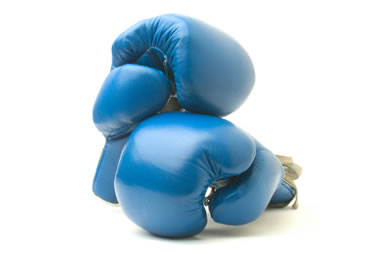By CD318156,
SparkPeople Blogger
7/7/2010
One of the most enjoyable aspects of running is you can basically do it anywhere in the world, whether on city streets, back country roads or in the comforts of a gym environment. All you need to do is lace up your running shoes and hit the trails. However, knowing how the different running surfaces impact your running form may help prevent aches and pains you may experience along the way.
Runners are said to experience the impact of three to four times their body weight over 800 times during just a one mile run. The harder the running surface, the greater the impact the body must absorb, which may lead to problems anywhere along the kinetic chain, from the foot to the upper back and everywhere in between.
Unfortunately, the minute one experiences an injury the shoes are the first thing we want to blame. After all they are the only so-called real equipment one needs to participate in the sport. But we should not ignore the fact that shoes are not always to blame when it comes to running injuries, particularly if you have do not vary your running surface.
If you were to ask most running experts what the ideal running surface is, you will likely receive a wide variety of responses. With running, the body is quite adaptable to the stress that we place on it, even when we are running on surfaces that are deemed less than ideal. But by varying our running surfaces we may be able to prevent may of the common overuse injuries experienced by runners of all skill levels.
Below is a list of the some of the most common running surfaces and how they impact your running form.
- Grass - Grass is considered to be the ideal running surface by many experts because of the soft, cushioning effect it provides. The softer surface means less impact for the body to endure with each foot strike. However, it is important to find a grassy surface that is smooth and level with the grass cut short enough so that the runner can see any irregularities.
Keep in mind though, grass running causes the muscles of the legs to work much harder when compared to other running surfaces and because of this, it may lead to ankle and feet issues, such as plantar fasciitis. It is advised that only those who are in good shape with flexible feet and strong ankles run on grass.
- Dirt Trails - Dirt trails, like grass, are considered to be one of the best running surfaces as they provide a similar cushioning effect to the joints. And because of the constant variation of the running surface, you are less likely to suffer an overuse injury. However, be cautious of dirt trails as tree roots, rocks and other debris can lead to the potential falls and other injuries.
- Synthetic Tracks - Stop by any of your local high schools and you may see a number of walkers and runners utilizing the outdoor running track. Polyurethane tracks have been found to be one of the best surfaces to run on as they provide less shock absorption when compared to other running surfaces.
A track is a great place to do speed work, such as intervals, but the redundancy of running around an ellipse may make it mentally tough to endure for longer runs.
Most tracks run in a counter-clockwise rotation, therefore if you decide to use a track as your only running surface you may notice aches and pains on the left side of your body. The reason, it is a natural inclination to lean slightly into the curve in which you are running.
Some running tracks will reverse the direction on a daily basis to avoid repetitive direction as this can lead to overuse injuries down the road.
- Asphalt - Because many of us live in communities without access to grass or running trails, asphalt can actually be one of the better road surfaces to run on, especially when compared to concrete. Asphalt, a combination of rock, tar and sand, provides a greater shock absorption for the legs. It is considered to be one of the fastest running surfaces and easy to measure.
However, note that because roads require proper drainage, there may be an arc or camber on the road which can create injury issues, especially if you elect to run alongside the curb. The reason, one leg is higher than the other, this knocks the body off balance. If that is your situation, it is advised that you alternate the sides of the street in which you run or better yet, run in the center of the road to avoid the slant.
Also note that asphalt can become quite hot as the sun's heat is absorbed by the black tar and the sun's rays are reflected off the surface which creates a warmer running environment. Be cautious too with your footing as pot holes can be quite common in asphalt roads, particularly after ice and heavy rains.
- Concrete - Unfortunately I live in a community where most of the running surfaces are comprised of concrete whether the streets themselves, or the local running courses that are made for runners. Concrete is considered to be one of the worst surfaces to run on as it causes the greatest impact to body. As with asphalt, be aware of the camber of the roads if you must do your running on this type of surface.
- Treadmills - Treadmills are a great alternative when the weather does not permit outdoor running. Please be aware, though, that they are not a substitute for road running as the treadmill does not allow for you to adjust to running on a harder, uneven surface. So if you plan on participating in a road race event, make sure you do some of your training outdoors, not only to allow your body time to adjust to running on a road surface, but to allow for adaptation to the environment.
- Sand - While many runners like the idea of running on the beach, it can be one of the least stable of all running surfaces. While sand ranks high in providing the least amount of impact to the body, it is one surface most experts note that can cause the greatest injuries to the legs, especially the calves and the Achilles tendon.
When running on loose sand, as the foot impacts the surface, it can become quite unstable, therefore causing the heel to sink into the sand providing a wider range of motion which can lead to major calf and Achilles tendon issues. These two injuries alone can derail a runner for months, maybe even years. And if you run on tightly packed wet sand, the slope of the surface close to the water's edge may lead to injuries similar to those found when running along the curb.
According to Bob Glover, author of The Runner's Handbook "beach running should be kept to no more than 10 minutes for new runners and 30 minutes for more advanced runners."
But for me, you will not find me running on the beach--the mere thought of tearing an Achilles tendon will keep me off the shore and running on a more stable surface--after all, how many of us race on this type of surface?
As with any other activity, variety is essential to keeping overuse injuries to a minimum. But use caution when you are changing running surfaces. Just a slight change in our form and foot plant can lead to issues anywhere along the kinetic chain.
Varying the surfaces on which you run may ward off potential injuries, while allowing you to build the endurance. However, it is important to note that if you plan to participate in a road race, be sure to find out the surface that you will be running on so that you can do some of your training runs on this surface to allow for some adaptation before the race.
Were you aware of how the different running surfaces may impact your running? What type of running surface do you most frequently run on? What surface would you like to try?
|
|








.jpg)














